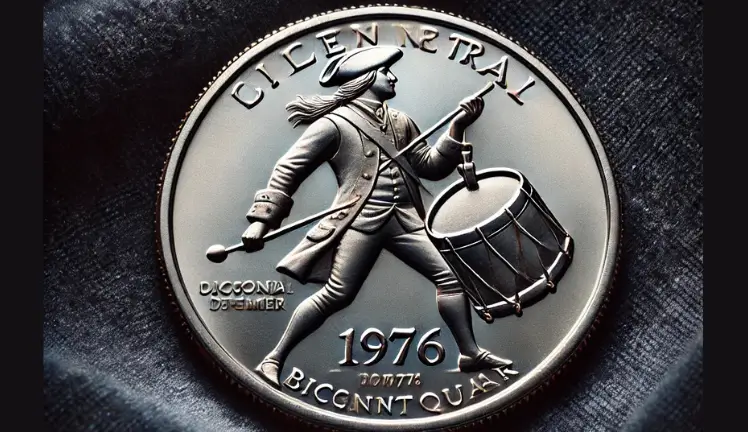Could a standard-looking quarter in your pocket be worth a staggering $1 million? In numismatics—the study and collecting of coins—such discoveries are not uncommon. One prime example is the Rare Bicentennial Quarter, minted in 1976 to honor America’s 200th birthday. While most of these commemorative quarters merely serve as pocket change, a select few stand out for their distinctive mint errors, unusual metallic content, or pristine condition. Together with seven other famously rare U.S. coins, they compose an impressive group that has collectively fetched over $75 million at auction.

Why Is the 1976 Bicentennial Quarter Special?
To celebrate two centuries of American independence, the U.S. Mint released quarters featuring a colonial drummer boy on the reverse and the dual date “1776–1976” on the obverse. Most of these quarters remain common. However, certain rare Bicentennial Quarter varieties contain:
- Silver Content (40%)
Specially minted proofs from San Francisco often command higher values due to their precious metal composition. - Doubled Die Errors
Misalignment in the minting process can create duplicated text or design features, enhancing a coin’s worth significantly. - Wrong Planchet Strikes
Coins accidentally stamped on undersized or foreign blanks can skyrocket in value due to their scarcity. - Experimental Materials
Extremely rare, unconfirmed aluminum or other trial-strike quarters are rumored to exist and could fetch six- or seven-figure sums.
7 Additional U.S. Coins That Can Make You a Millionaire
Aside from the Rare Bicentennial Quarter, these seven coins hold legendary status among collectors and investors:
- 1933 Saint-Gaudens Double Eagle
- A $20 gold coin halted before official release. Most were melted down, and only a handful survived. In 2021, one sold for $18.9 million.
- 1794 Flowing Hair Silver Dollar
- Among the earliest U.S. silver dollars minted. A specimen fetched $10 million in 2013, cementing its historic significance.
- 1787 Brasher Doubloon
- Privately minted in gold by Ephraim Brasher. A revered piece of early American coinage, selling for $9.36 million in 2021.
- 1913 Liberty Head Nickel
- Only five known examples exist. One of the most enigmatic coins, with a record sale of $4.56 million in 2018.
- 1894-S Barber Dime
- Rumored that only 24 were minted; fewer survive. A pristine specimen can garner up to $2 million.
- 1804 Draped Bust Dollar
- Nicknamed “The King of American Coins.” Its rarity and storied past have driven prices up to $7.68 million.
- 1861 Paquet Reverse Double Eagle
- Features an experimental reverse design by Anthony Paquet. Very few remain, making it a coveted treasure that recently sold for $1.6 million.
How to Identify a Potentially Rare Bicentennial Quarter
- Check the Date and Mint Mark
- Look for “1976” with an “S” for San Francisco. Denver (“D”) and Philadelphia (“P” or no mint mark) coins can be valuable if they exhibit specific errors.
- Search for Striking Errors
- Use a magnifying glass to spot anomalies like off-center strikes, doubled die text, or missing mint marks—often the hallmark of collectible rarities.
- Assess Condition
- Quarters grading MS-67 or higher typically fetch premium prices. Protective handling—e.g., using gloves and storage flips—preserves surface quality.
- Consult Professionals
- If you suspect you have a valuable quarter, submit it to a recognized grading service like PCGS or NGC for official evaluation.
- Monitor Recent Auctions
- Stay informed through auction platforms such as Heritage Auctions or GreatCollections to track pricing trends and confirm current demand.
Read Also:
New $495 Social Security Payment Proposal: Who Qualifies and What You Should Know
FAQs
- Are all Bicentennial Quarters worth more than 25 cents?
No. Most 1776–1976 quarters are still worth face value. Only those with unique errors, precious metals, or high mint-state grades attract large bids. - How can I safely store rare coins?
Store them in non-PVC holders or acid-free sleeves, away from humidity and extreme temperatures. Avoid cleaning them, as it can lower value. - Where is the best place to sell rare coins?
Reputable coin dealers, established auction houses, or certified online marketplaces. Always authenticate high-value coins before selling. - What should I look for in a coin appraisal service?
Choose certified numismatists or professional grading companies. Their certifications and reputation are crucial for fair market value. - Could I find a rare coin in my pocket change today?
It’s uncommon but possible. Older coins or error coins occasionally remain in circulation, making an unexpected discovery entirely feasible.
Disclaimer: Values and sales figures referenced are subject to change based on market conditions and auction results. Always consult professional coin graders for accurate assessments.